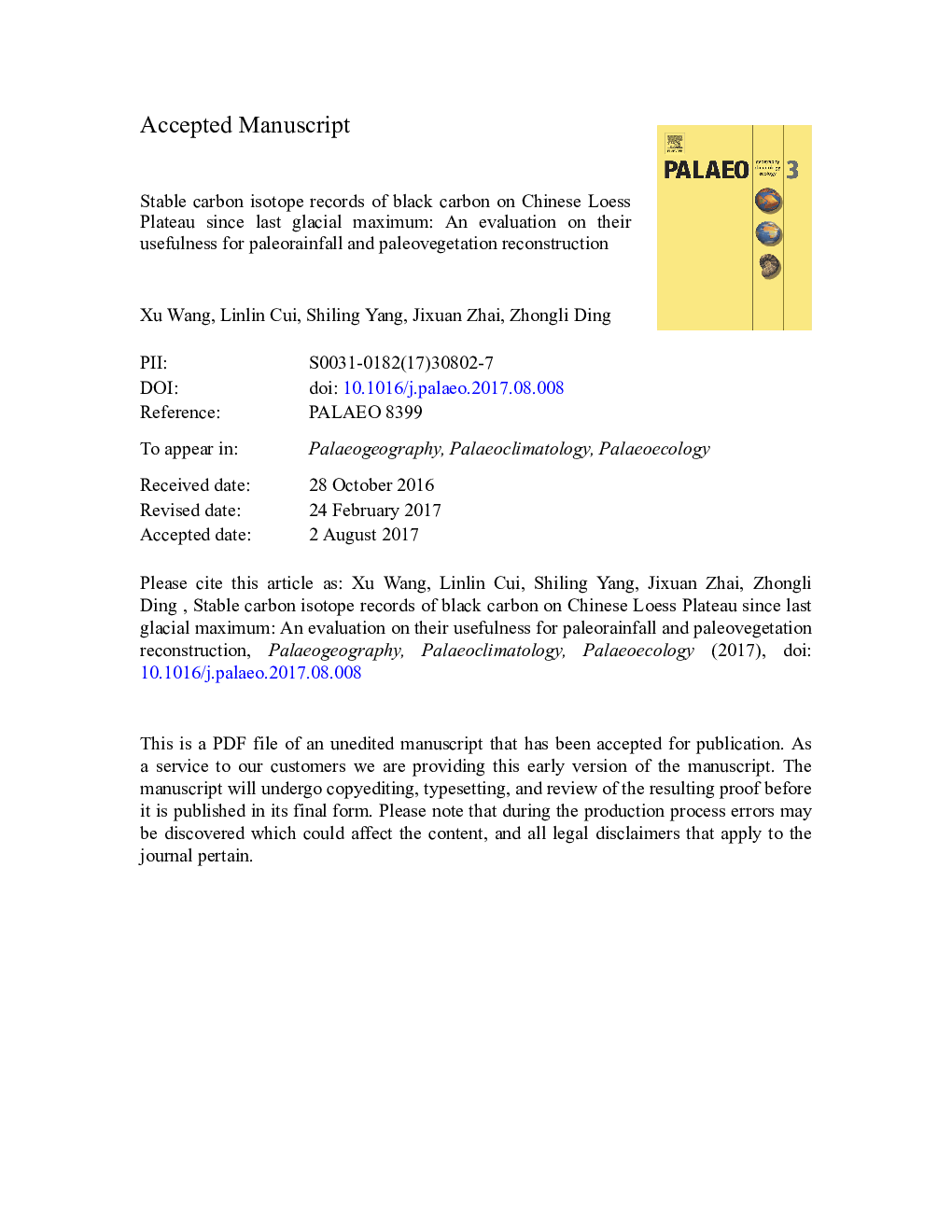| کد مقاله | کد نشریه | سال انتشار | مقاله انگلیسی | نسخه تمام متن |
|---|---|---|---|---|
| 10223631 | 1701039 | 2018 | 38 صفحه PDF | دانلود رایگان |
عنوان انگلیسی مقاله ISI
Stable carbon isotope records of black carbon on Chinese Loess Plateau since last glacial maximum: An evaluation on their usefulness for paleorainfall and paleovegetation reconstruction
ترجمه فارسی عنوان
سوابق ایزوتوپ کربن ثابت کربن سیاه در صفحات چسنی چینی از زمان آخرین حداکثر یخبندان: ارزیابی سودمندی آنها برای بازسازی کمربندها
دانلود مقاله + سفارش ترجمه
دانلود مقاله ISI انگلیسی
رایگان برای ایرانیان
کلمات کلیدی
موضوعات مرتبط
مهندسی و علوم پایه
علوم زمین و سیارات
فرآیندهای سطح زمین
چکیده انگلیسی
Stable carbon isotope composition of soil organic matter (δ13CSOM) has been widely used to infer past environmental or vegetation (C3/C4) changes. However, as a carbonaceous product of incomplete burning of biomass, the carbon isotope signature of black carbon (BC) has received little study and a limited usage on this purpose. Moreover, the environmental or vegetation indication of BC carbon isotope composition (δ13CBC) in sedimentary records remains ambiguous although the δ13CBC is supposed to reflect carbon isotope composition of vegetation being burnt. This deserves site-specific studies. Here we analyzed δ13CBC and δ13CSOM on loess-paleosol samples from Lijiayuan and Yangling sections on Chinese Loess Plateau (CLP) spanning the last glacial maximum to decipher the environmental (or vegetation) meaning of δ13CBC at each study site. Opposite changing patterns were observed on the δ13CBC values for the two sections. The δ13CBC at Yangling (in southern part of the CLP) varied from â 19.18â° to â 21.93â° (mean: â 20.62â°) with more positive values occurred during the middle Holocene than those during the LGM, demonstrating more C4 plants occupied in the region during the warm-humid middle Holocene. This is consistent with the changing pattern widely-documented in δ13CSOM records over the CLP during the same period. By contrast, the δ13CBC at Lijiayuan (in northwestern part of the CLP) changed within the range of â 21.83â°Â ~ â 24.64â° (mean: â 23.34â°) and displayed more negative values during the early-middle Holocene with respect to the LGM period. The δ13CBC at Lijiayuan were about 2.5â° lower than those at Yangling, indicating a northward decrease of C4 plants on the CLP. The anti-phased changes of δ13CBC at Lijiayuan were considered to reflect variations in paleorainfall because the vegetation is dominated by C3 plants at the study site and carbon isotope compositions of C3 plants decrease as rainfall increases. Compared with δ13CSOM record at the same profile, δ13CBC seem biased against capturing C4 signal during mid-Holocene possibly due to dominance of C3 plants at the study site during fire seasons and a potentially extra source of BC from forest fires occurred on surrounding mountains. By contrast, δ13CBC tend to exaggerate C4 signal during the LGM attributed to a possible shift of fire season from spring to summer. These findings suggest that we probably underestimate the abundance of C4 plants during mid-Holocene and overestimate C4 biomass during the LGM using BC carbon isotope composition.
ناشر
Database: Elsevier - ScienceDirect (ساینس دایرکت)
Journal: Palaeogeography, Palaeoclimatology, Palaeoecology - Volume 509, 15 November 2018, Pages 98-104
Journal: Palaeogeography, Palaeoclimatology, Palaeoecology - Volume 509, 15 November 2018, Pages 98-104
نویسندگان
Xu Wang, Linlin Cui, Shiling Yang, Jixuan Zhai, Zhongli Ding,
